Ivan van Sertima also discussed the Mali expedition to the Americas.
In A.D. 1312, Emperor Abubakari Muhammad , of Mali gave his throne to Mansa Musa and embarked with his fleet into the Atlantic Ocean in search of the continent opposite Africa. Archaeological and epigraphic evidence indicates that Abubakari, and or members of his expedition settled in pre-Columbian Brazil.
The Indians have a tradition that Mansar Akban was the leader of another tribe which discovered the Cunan people.This Mansar Akban, may be a reference to Mansa Abubakari, who led the Malian voyagers to the Americas.
The Manding lived in mounds along the Niger rivers. The mound cultures of ancient America were built by Africans primarily Manding. The people of the Niger Delta formed river riverine communities which were partly vegetation with some aquatic animals were eaten.
The ancient Manding built several types of homes. In ancient times they built masonry houses and cliff dwellings identical to those found in the American Southwest. In Medieval times they lived on mounds in the most watery areas in their circular huts made a stone and wood on the top and their fields in front of the mounds tilled each day.
The Malian people introduced their technology to the Americas. The Manding built dwellings depending on the topography . Near rivers they lived on mounds. In semi-arid regions they lived in cliff houses, like
those found in the Southwest. Today the Dogon who trace their descent to the Mande live in identical dwellings as those found in Colorado ,where Manding inscriptions dating to the A.D. 1000 's have been found related to the
Pueblo culture.
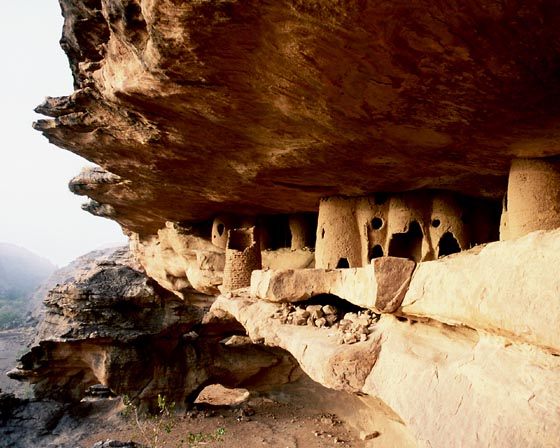
Tellem Cliff Dwellings from West Africa
The most common signs found in Mandeland and the American southwest
are habitation signs painted in red at Anasazi. These signs agree with Mande signs along the Niger river in Africa.
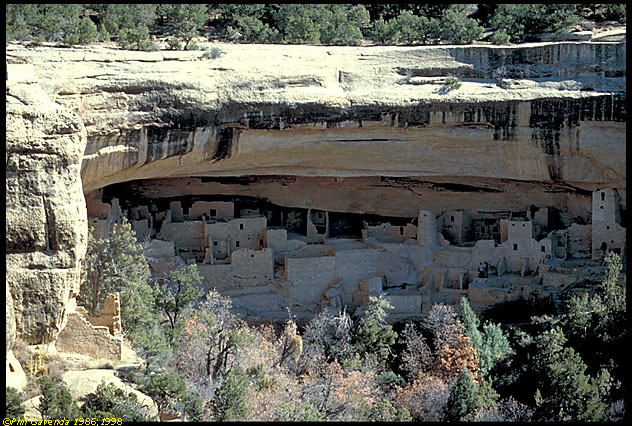

Cliff Dwellings from Anasazi
The Malian ships or canoes plowing down the NIger were operated by the Bozo
and Sorko fishermen. The Bozo lived along the western arm of the Niger bend. The Sorko people, who spoke Songhay language submitted to Manding
rule. The Bozo and Sorko, were the masters of the Niger river transport.
[IMG] http://www.olmec98.net/SewnMalinkeboat.jpg[/IMG]
 Mande Sewn
Boat
Mande Sewn
BoatMany of the ships of the NIger could carry burdens of 60-80 tons. These
canoes were ninety to one hundred feet long. The men usually sat three
abreast with ease. Around forty men paddled.
Other canoes were joined together. These canoes were forty feet long and five feet across. These jointed boats were mainly navigated by the Bozo. In addition to canoes the fishermen along the Niger built rope sewn
plank boats ninety to one hundred feet long.
Around A.D. 1310, thousands of Manding speakers arrived in the Americas
from ancient Mali. Ibn Fadlullah al- Umari, in his encyclopedia "Masalik al Absar", said the mariners from Mali during the reign of Abubakari made transatlantic voyages. Al-Umari, obtained his information from Mansa Musa,
who was handed the kingship of Mali by Abubakari when he set out to colonize the Americas.
Mansa Musa, said that Mansa Abubakari would not believe that it was impossible to discover the limits of the neighboring sea (the Atlantic). Musa, told al-Umari that:"so he sent out 200 ships equipped and filled with
men and the same number filled with gold, water and enough food to last them for years. Muhammad Abubakari, commanded that the captain not return
until the supplies were exhausted".
After sometime, according to Mansa Musa, a single ship returned and the captain was ordered to report his findings. "Prince", he replied
"we sailed for a long time up to the moment when we encountered in mid-Ocean
something like a river with a violent current. My ship was last. The others sailed on...they disappeared and did not come back".
"But the Emperor[Abubakari] did not believe him", continued Musa,"He equipped two thousand vessels, a thousand for himself, and a thousand for water and supplies. He conferred power on me [Mansa Musa] and left with his companions on the ocean".
The expeditionary force of Mansa Abubakari, must have been immense, because the average boat on the Niger, in the 1500's A.D., could carry 80 men. This means that anywhere between 25,000 to 80,000 men may have sailed
from Mali along with Mansa Abubakari.
The mention of a violent current in mid-ocean by Abubakari's captain
may refer to the Atlantic ocean currents which can carry a boat from Africa to the Americas.
We can hypothesize that Abubakari and his expeditionary force probably
left the city of Niani, by canoe and traveled down the NIger to the Gulf of
Guinea. From here the expeditionary force was probably carried by the Guinea
Current out into the Atlantic where it met the South Equatorial Current. The
South Equatorial Current carried the Mali explorers to Brazil.
Abubakari's ships would not be the last vessels to be carried to
Brazil. For example, in 1500 , Alvares Cabral's ship was captured by the
North Equatorial Current and swiftly taken to Brazil.
In Mexico the Malian wanders are depicted in the Mixtec Codex Dorenberg
(fourtenth century). These migrates are bearded, they have large noses and
lips, and are represented with black skins. In addition,to the Codex
Dorenberg they are also seen in the Codex Tro, with staff or spear in hand,
feathered headdresses, polished earrings, cloaks and loincloths made of the
finest woven cotton. They wore arm and wrist bands, and small white shells
on their ankles which rattled as they walked , usually in groups of two's or
three's.
In Mexico, due to previous cultural development the Manding found
large heavily populated Indian communities. Therefore the Malian colonists
did not establish any large communities in Mexico, but they were active
traders and are remembered for their merchandise.
The are Mexican traditions of groups of foreigners moving northward
throughout the early 14th century. These men probably formed the vanguard of
a larger body of Malians which probably entered Mexico in 1325, and fought
the Mexicans around this time for land to settle. The battle of these
Africans and Amerindians, is seen in the legend of a battle between an eagle
and a serpent and the choice of the site of the battle as the place to build
Mexico's Tenochititlan. The serpent is the totem of the Manding, it
therefore probably represents the Malian forces, and the eagles the
Amerindians. Among these foreign migratory groups it is reported in
Amerindian traditions that they took the practice of agriculture and pottery
making to the Chichimecs, and helped design and build the houses around
Lake Texcoco in 1327.
ANASAZI
The Manding mentioned in the Mexican traditions of 1325, may represent
the founders of Anasazi civilization of Four Corners section of the United
States. Anasazi, is a Navajo word which means "Ancient Ones" for the
founders of the spectacular cliff dwellings and great multistoried pueblos
erected on open plains near the San Juan, Salt and Little Colorado rivers.
Although American anthropologists accept the theory that the Amerindians
entered North America across the Bering Strait about 20000-15000 years ago
, the Hopis, on the contrary say their ancestors crossed the sea during
their emergence to this present Fourth World, arriving somewhere along the
coast of Mexico or Central America, then gradually worked their way
northward to settle in their present homes in the Four Corners region.
They call the original inhabitants of the cliff dwellings "Ancient
Ones". These Anasazi were probably Manding speakers. The ruins of their
great stone cities are crouched low on the Mesa tops or nestled in caves
along the sheer canyon walls of this high desert region. These stone cities
are exact replicas of stone cities cliff dwellings found in West African
areas that formerly formed part of the Mali empire, especially the Dogon
towns.
In what is now known as Four Corners region where the states of Utah,
Colorado, New Mexico and Arizona come together at a common point the Anasazi
tilled the earth and even irrigated their crops, and stored some of the
harvest for later use.

The Manding mentioned in the Mexican traditions of 1325, may represent the founders of Anasazi civilization of Four Corners section of the United States. Anasazi, is a Navajo word which means "Ancient Ones" for the founders of the spectacular cliff dwellings and great multistoried pueblos erected on open plains near the San Juan, Salt and Little Colorado rivers.
Although American anthropologists accept the theory that the Amerindians entered North America across the Bering Strait about 20000-15000 years ago , the Hopis, on the contrary say their ancestors crossed the sea during their emergence to this present Fourth World, arriving somewhere along the coast of Mexico or Central America, then gradually worked their way northward to settle in their present homes in the Four Corners region.
They call the original inhabitants of the cliff dwellings "Ancient Ones". These Anasazi were probably Manding speakers. The ruins of their great stone cities are crouched low on the Mesa tops or nestled in caves along the sheer canyon walls of this high desert region. These stone cities are exact replicas of stone cities cliff dwellings found in West African areas that formerly formed part of the Mali empire, especially the Dogon towns. These Ancient Ones, may have been members of the mande speaking group.
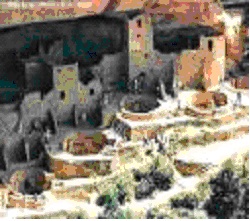
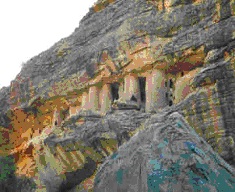
- Four Corner Cliff Dwellings West African Cliff Dwellings
Anasazi is a Navajo word which means “Ancient Ones” for the founders of the spectacular cliff dwellings and great multistoried pueblos erected on open plains near San Juan, and the Salt and Little Colorado rivers. The Anasazi or manding tilled the earth and even irrigated their crops, and stored some of the harvest for later use.
There were many African communities found by the Spainish in the Southern part of the United Staes and Florida [1].
Quatrefages speaks of black men who penetrated to the American southwest while other Africans migrated into Southern California [2]. And as late as 1775, Father Francisco Garces discovered a race of Black men, clearly African, residing in a community beside the Zuni Indians in New Mexico. According to Quatrefages the two races spoke different languages.
In 1528, the Spanish explorer Cabeza de Vaca and Estevanico the Moor (Blackman) from Azamor discovered numerous people living in the American Southwest as they sought to discover the Seven Cities of Cibola. The Seven Cities of Cibola were suppose to be centers where fantastic amounts of gold could be found.
In what is now known as Four Corners region where the states of Utah, Colorado, New Mexico and Arizona come together at a common point the Anasazi tilled the earth and even irrigated their crops, and stored some of the harvest for later use.
The presence of Manding in Four Corners, is supported by the appearance of Dogon and Bambara ideograms, called petroglyphs, on rocks in the Anasazi area. Moreover, there are several tablets found in Four Corners which have been deciphered that were written in an aspect of Malinke.
In the Four Corners region de Vaca, found various ethnic groups speaking a multiplicity of languages. Due to the pluralistic nature of these societies the people could only communicate using sign language . Ceram noted that:
“In reality the inhabitants of the pueblos, as we now know, were members of extraordinarily varied tribes. They spoke widely differentlanguages and had different historical backgrounds”[3].
De Vaca said that one of these ethnic groups was named Mendica[4]. This name is almost identical to the word Mandinka (Malinke), the name of one of the Manding speaking people.
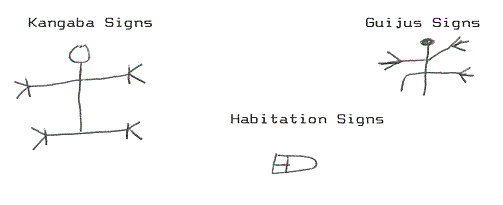
In the Anasazi area we find many depictions of the Malinke- Bambara habitation sign and Kangaba sign in the American southwest. This sign is frequently found in West Africa, in areas settled by the Mande speaking people. The Kangaba sign, is clearly depicted among the glyphs found in the Guijus range of southern Arizona.
Southwest Petroglyph

The ruins of the Anasazi stone cities are crouched low on the Mesa tops or nestled in caves along the sheer canyon walls of this high desert region. These stone cities are the exact replica of stone cliff dwellings found in West African areas that formerly formed part of the Mali empire, especially the Dogon towns.
Dogon Cliff Dwelling
Due to the spread of nomadic Amerindians from the northwest,the Anasazi were forced from their stone cities and cliff dwellings by the invaders. There was probably some intermarriage between Africans and Amerindians and today we see a negroid strain among the southwestern Amerindian populations[5]. In addition many African communities were found in the Southwest when Europeans arrived in this part of the United States.
Mesa Verde Mande Habitation Sign

In summary the archaeological and historical evidence from Africa and the Americas coupled with the decipherment of ancient scripts used in the New World illustrates that people from ancient Mali, probably led by Mansa Abubakari, colonized many parts of the Americas during the first quarter of the 14th Century A.D. These Mande speaking people, like the Olmecs before them had a tremendous influence on American civilizations especially in the development of trade in Mexico .
The Inscription from Palatki is written in the Manding language. It was found near the ruins of cliff dwellings.


Palatki Cliff Dwellings.
The Palatki cliff dwellings are similar to the Tellem Cliff Houses.

Malian Cliff Dwellings from Tellem
The Malians left many inscriptions in the Southwestern part of the United States. The presence of Manding in Four Corners, is supported by the appearance of Dogon and Bambara ideograms, called petroglyphs, on rocks in the Anasazi area. Moreover, there are several tablets found in Four Corners which have been deciphered that were written in an aspect of Malinke.
The Pilatki inscriptions is also written in Manding not Sanskrit. Below we see the following signs.

The Malinke inscriptions were read from right to left. Top to bottom. There are five Malinke or Mande signs on the Palatki inscriptions. The inscription says:
Be
su i se
Se Gyo/Jo
The English translation is as follows:
“Exist here a superior place
Of habitation. Make (this) place
a success, consecrated to the
Divinity”
In conclusion, in 1310 thousands of Malians arrived in the Americas. Many of these Malians settled throughout South America and the American Southwest where they left numerous inscriptions written in the Malinke Bambara language that was spoken by the Malian court.
The Palatki inscription is written in the Mande language not Sanskrit. This inscription describes the picturesque setting where the Palatki inscription and cave dwellings were found.
Due to the spread of nomadic Amerindians from the northwest,the
Anasazi were forced from their stone cities and cliff dwellings by the
invaders. There was probably some intermarriage between Africans and
Amerindians and today we see a negroid strain among the southwestern
Amerindian populations. In addition many African communities were found in the Southwest when Europeans arrived in this part of the United States.
Footnotes:
1 M.O. y Berra, Historia antique y de Conquista de Mexico, Mexico, 1960.
2 L.H. Clegg, “The Black origin of American civilization”, A Current Biblioraphy on African Affairs, No.1 (1976),pp.2-22.
3 C.W. Ceram, The First Americans, (New York,1971) p.70.
4. Ibid.,
5 P.S. Martin, G.I. Quimby and D. Collier, Indians Before Columbus, (Chicago: University of Chicago Press, 1970) p.19.

No comments:
Post a Comment